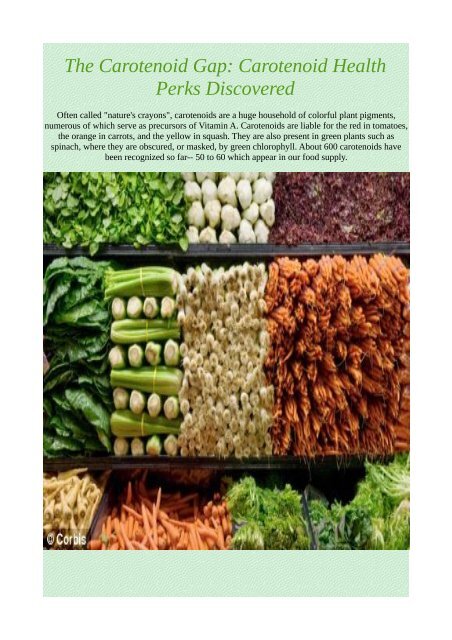The Carotenoid Gap: Carotenoid Health Perks Discovered
Often called "nature's crayons", carotenoids are a huge household of colorful plant pigments, numerous of which serve as precursors of Vitamin A. Carotenoids are liable for the red in tomatoes, the orange in carrots, and the yellow in squash. They are also present in green plants such as spinach, where they are obscured, or masked, by green chlorophyll.
Often called "nature's crayons", carotenoids are a huge household of colorful plant pigments, numerous of which serve as precursors of Vitamin A. Carotenoids are liable for the red in tomatoes, the orange in carrots, and the yellow in squash. They are also present in green plants such as spinach, where they are obscured, or masked, by green chlorophyll.
Create successful ePaper yourself
Turn your PDF publications into a flip-book with our unique Google optimized e-Paper software.
<strong>The</strong> <strong>Carotenoid</strong> <strong>Gap</strong>: <strong>Carotenoid</strong> <strong>Health</strong><br />
<strong>Perks</strong> <strong>Discovered</strong><br />
Often called "nature's crayons", carotenoids are a huge household of colorful plant pigments,<br />
numerous of which serve as precursors of Vitamin A. <strong>Carotenoid</strong>s are liable for the red in tomatoes,<br />
the orange in carrots, and the yellow in squash. <strong>The</strong>y are also present in green plants such as<br />
spinach, where they are obscured, or masked, by green chlorophyll. About 600 carotenoids have<br />
been recognized so far-- 50 to 60 which appear in our food supply.
<strong>Carotenoid</strong> Wellness Link <strong>Discovered</strong><br />
<strong>The</strong> very first ideas linking carotenoids and health appeared in the 1970's. <strong>The</strong>se findings stimulated<br />
many new study efforts focusing on various facets of the diet/disease equation, consisting of low-fat<br />
versus high-fiber intake, vegetarian versus meat diets, and the consumption of particular nutrients<br />
discovered in fruits and veggies-- especially beta-carotene.<br />
Beta-Carotene: No Longer the Only <strong>Carotenoid</strong> in the area!<br />
Beta-carotene swiftly became the "star" in both clinical literature and the media, as research showed<br />
that diets high in beta-carotene-rich foods clearly provided health advantages distinct from those<br />
provided by other nutritional factors. While beta-carotene is the most popular carotenoid, it is just<br />
one member of a big "family" with about 600 members, including alpha-carotene, gamma-carotene,<br />
zeta-carotene, lycopene, zeaxanthin, lutein and beta-cryptographic. Research continues to unwind<br />
healthful functions for the other carotenoid relative, as well as beta-carotene.<br />
Beta-carotene never appears in seclusion in vegetables and fruits, and neither do the other<br />
carotenoids. Broad-spectrum carotenoids work together in veggies and fruits to promote wellness,<br />
with optimum levels and ratios of each needed for optimum security.
Experts Develop Nutritional Guidelines<br />
Acknowledging the outstanding benefits of a diet plan high in carotene-rich fruits and veggies,<br />
health experts have actually established a series of main dietary recommendations.<br />
-- <strong>The</strong> National Academy of Science suggests consuming 5 or more daily servings of vegetables and<br />
fruits, yellow/orange and especially green vegetables.<br />
-- <strong>The</strong> United States Department of Agriculture, together with the Department of Wellness and<br />
Person Solutions, recommends eating 2 to four portions of fruit, and three to 5 portions of veggies<br />
daily.<br />
<strong>The</strong> "<strong>Carotenoid</strong> Space".<br />
Clear as these recommendations are, it continues to be similarly clear that they aren't being met!<br />
Recent research studies revealed that on any given day:.<br />
Almost half of all Americans consume NO fruit.<br />
Nearly one-quarter eat NO veggies.<br />
Just 9 percent in fact eat five portions of veggies and fruits, the low end of the recommended variety<br />
of 5 to 9.<br />
In reality, although some professionals suggest eating at least 6 mg of carotenoids daily, scientists<br />
estimate that most of us are really getting only about 1.5 mg every day-- a substantial carotenoid<br />
space.<br />
This gap is not unique to the American diet, according to Dr. Gladys Block of the Department of<br />
Cancer Prevention and Control at the United States National Cancer Institute. "It is likely that<br />
considerable public health advantage might be attained if usage of vegetables and fruits were<br />
substantially enhanced over the levels seen in the United States and other industrialized countries.".<br />
Proven Absorption for Optimum Advantages.<br />
In raw fruits and veggies, carotenoids are bound to proteins-- as little as 1 % of the beta-carotene in<br />
raw carrots might be soaked up. What's more, really high levels of a single carotenoid can inhibit<br />
absorption of other vital carotenoids.
<strong>The</strong> Whole Food Difference.<br />
Bear in mind: Single carotenoids do not happen in isolation in natural foods-- they accompany their<br />
other carotenoid "family members". In truth, the significance and individuality of the carotenoid<br />
group depends on their household structure each member contributes safety benefits and works<br />
together as a team to provide maximum benefits at Pittman and Davis Coupon Code.<br />
Be sure to supplement with a carotenoid whole-food supplement if you are not consuming 2 to four<br />
portions of fruit, and 3 to 5 servings of veggies daily. If you are supplementing with a carotenoid<br />
food supplement, ensure it contains all 600 carotenoids, and not simply a few, to even be effective<br />
and not shake off your dietary balance.<br />
Sometimes called "nature's crayons", carotenoids are a huge household of vibrant plant pigments,<br />
numerous of which act as precursors of Vitamin A. <strong>Carotenoid</strong>s are responsible for the red in<br />
tomatoes, the orange in carrots, and the yellow in squash. <strong>The</strong> first hints connecting carotenoids and<br />
health appeared in the 1970's. While beta-carotene is the most popular carotenoid, it is simply one<br />
member of a big "household" with about 600 members, consisting of alpha-carotene, gammacarotene,<br />
zeta-carotene, lycopene, beta-cryptographic, lutein and zeaxanthin.<br />
In raw fruits and veggies, carotenoids are bound to proteins-- as little as 1 % of the beta-carotene in<br />
raw carrots could be soaked up. What's even more, really high levels of a single carotenoid can<br />
inhibit absorption of other essential carotenoids.


















